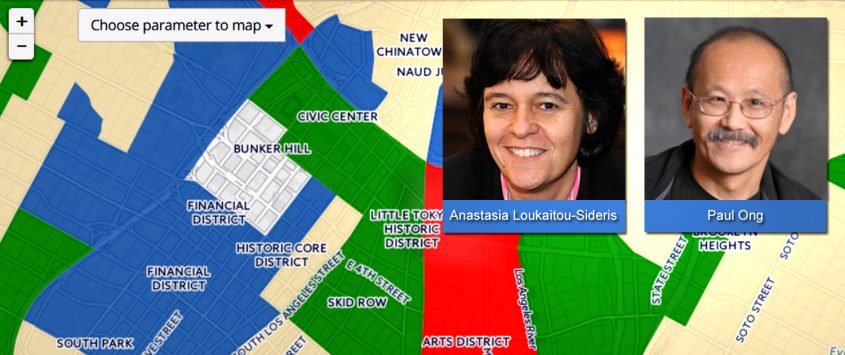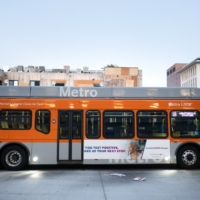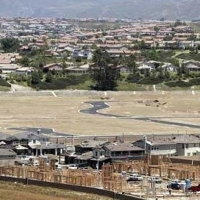
Gentrification and Displacement in Southern California UCLA urban planners release online mapping tool to help analyze impact of developments near Los Angeles area transit projects. The goal? ‘Progress that is fair and just’
By Stan Paul
A team of researchers at the UCLA Luskin School of Public Affairs has created an interactive mapping tool to help community leaders better understand the effects of new light-rail and subway projects and related developments — especially on low-income communities.
Researchers view the project as a resource to help communities and policymakers identify the pressures associated with development and figure out how to take more effective action to ensure that new construction isn’t always accompanied by current residents being priced out of their neighborhoods.
The Southern California portion of the joint UCLA-UC Berkeley Urban Displacement Project on gentrification and displacement in urban communities is available online.
“There has been a strong interest in neighborhoods around subway stations and light-rail stops,” said Paul Ong, director of UCLA Luskin’s Center for Neighborhood Knowledge and a professor of Urban Planning. “These locations have the potential for extensive private investments because transit gives people an alternative to using cars. This is particularly attractive to today’s young professionals.”
However, according to Ong, the downside to this “upscaling” is that changing the character of a neighborhood with additional transportation options can lead to lower-income disadvantaged households being pushed out.
“Sometimes, landlords aggressively — and perhaps illegally — force them out,” said Ong, who is also a member of the UCLA Institute of the Environment and Sustainability. “Higher rents make it difficult for low-income households to move into the neighborhood, so we see a net decline in their numbers. They are replaced by those who can afford the higher housing cost — people referred to as ‘gentrifiers.’”
Ong said that most of those who can afford higher housing costs do not purposefully want to displace people living in poorer households, “but, nonetheless, gentrifiers are a part of the larger socioeconomic process.” The goal of the Urban Displacement Project, according to the researchers, is not to stop neighborhood change because many people can benefit from these developments. “The challenge,” Ong said, “is ensuring that progress is fair and just.”
The UCLA team, funded in part by the California Air Resources Board, created a database for the Los Angeles County region that included information on demographics, socio-economic and housing characteristics in neighborhoods that are near transit projects and those that are not.
Key findings by UCLA researchers for L.A. County include:
- Areas around transit stations are changing and many of the changes are in the direction of neighborhood upscaling and gentrification.
- Examining changes relative to areas not near light-rail or subway projects from 2000 to 2013, neighborhoods near those forms of transit are more associated with increases in white, college-educated, higher-income households and greater increases in the cost of rents. Conversely, neighborhoods near rail development are associated with greater losses in disadvantaged populations, including individuals with less than a high school diploma and lower-income households.
- The impacts vary across locations, but the biggest impacts seem to be around the downtown areas where transit-oriented developments interact with other interventions aiming to physically revitalize those neighborhoods.
Users of the mapping tool can examine neighborhood-level data on racial/ethnic composition, which areas have seen upscaling, gentrification, population density, percentage of people living in poverty, median household income and level of education. More specific data is also available, including the number of households with a Section 8 housing voucher and low-income housing tax credits.
“Our goal is that local and state governments will use the information to guide decisions regarding public investments that are just; community groups will use the information to help tell their stories of preserving the best parts of their neighborhood; and engaged citizens will become more aware of critical issues facing society,” Ong said.
As part of the study, the Bay Area team analyzed nine case studies and the UCLA team looked at six more in L.A. County to capture geographic diversity and to examine different stages of the gentrification and displacement process.
“Also, we want to focus in more detail on the phenomenon of commercial gentrification, which leads to the closing down of mom-and-pop stores and ethnic small businesses in some neighborhoods,” said Anastasia Loukaitou-Sideris, principal investigator on the Los Angeles team. Most of the existing studies focus only on residential gentrification said Loukaitou-Sideris, professor of urban planning and associate dean of the Luskin School.
For example, the UCLA team looked at studies based on the “live experiences of real communities” such as six disadvantaged neighborhoods located near Los Angeles Metro Rail stations. The also examined the impacts on Asian-American businesses near transit-oriented developments, as well as the impact of new outlets such as Wal-Mart and Starbucks on ethnic small businesses in L.A.’s Chinatown.
Loukaitou-Sideris said the researchers discovered one important difference between the strategies used by Los Angeles and the Bay Area.
“We found that Bay Area municipalities have in their books many more anti-displacement policies than municipalities in L.A. County,” she said. “However, we do not know yet how effective these policies have been in limiting displacement.”








Leave a Reply
Want to join the discussion?Feel free to contribute!